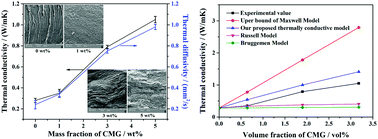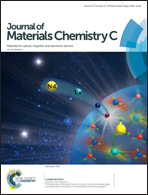Significantly enhanced and precisely modeled thermal conductivity in polyimide nanocomposites with chemically modified graphene via in situ polymerization and electrospinning-hot press technology
Abstract
Both aminopropylisobutyl polyhedral oligomeric silsesquioxane (NH2-POSS) and hydrazine monohydrate were utilized to functionalize graphene oxide (GO), and to obtain chemically modified graphene (CMG), which was then used for preparing thermally conductive CMG/polyimide (CMG/PI) nanocomposites via a sequential in situ polymerization and electrospinning-hot press technology. NH2-POSS molecules were grafted on the GO surface, and CMG was obtained by the reaction between NH2-POSS and GO. The thermal conductivity coefficient (λ), glass transition temperature (Tg) and heat resistance index (THRI) of the prepared CMG/PI nanocomposites were all increased with increasing the CMG loading. The λ value of the CMG/PI nanocomposites with 5 wt% CMG was significantly improved to 1.05 W m−1 K−1, about 4 times higher than that of the pristine PI matrix (0.28 W m−1 K−1). The corresponding Tg and THRI values were also increased to 213.0 and 282.3 °C, respectively. Moreover, an improved thermal conductivity model was proposed and predicted the λ values of the nanocomposites more precisely than those obtained from the typical Maxwell, Russell and Bruggemen classical models.



 Please wait while we load your content...
Please wait while we load your content...